Tony Shulthise, Innovator at Techshot (USA)
Tony subscribed to my CNC newsletter and in one of them, I described why I picked a 3D Systems Cube over a Makerbot (then an independent open-source company) – he was in the same position as me around the same time but he went one 3D printer larger, the 3D Systems CubeX! I had seriously considered this myself but I knew my Cube would be my first and last extrusion 3D printer and I just didn’t see the value for me of printing my 3D models bigger just for the sake of doing so. Although my experience with my Cube has been great, as you’ll read, his experience was the opposite of mine and here’s the reply he sent to me.
Jon,
Your article struck me because your opinions paralleled mine as of this time last year. Since then I’ve had a lot of experience with the open source community and 3D printers and my opinions have changed quite a bit.
I just read over your article about why you chose the Cube over Makerbot. I wish there were a way for me to comment on that article because I believe it is missing some important information.
I bought a CubeX as my first 3D printer about the same time you wrote that article. I hated it. It didn’t print well and tech support was terrible. It eventually self destructed and I was one of the few to get my money back.
The main problem with Cubify products is that they require proprietary filament which they charge 400% to 500% more for than the same quality filament that all other printers use. Also, their printers don’t have a heated bed which is very important for decent ABS prints.
I bought a Lulzbot TAZ after the CubeX and it was better but not great. I bought a Makergear M2 next and it has pretty much been what I had hoped a 3D printer would be all along. Most of my prints come out great. The Makerbot Replicator 2 is similar in quality. Almost any printer out there will give better results than the Cubify products at about 20% of the cost in the long run.
I also suggest that you get to know the open source community a little better. I felt exactly as you expressed that you do in your article. However, I have seen that the open source community offers a lot to the world and to whatever products they end up supporting. Get to know one of their leaders and see if it doesn’t change your opinions. I think it might.
Thanks for all of your contributions,
Tony
Well, this needs to be fleshed-out! As for me, I knew about the issues with ABS without a heated bed which is why I’ve only used PLA (read http://cncking.com/why-i-choose-pla-over-abs-for-my-3d-printer/) for my 3D printer and the cartridges were the reason I bought my Cube, filament tends to dry-out and cause flow errors if not well isolated from the environment.
So I asked if Tony would be interested in being interviewed for my CNCKingdom.com blog about his experience – he is a Mechanical Engineer and business development officer at Techshot – and he thankfully agreed! If you are interested in getting into 3D printer, this interview is easily the best I’ve ever been able to read!
You can contact Tony at http://Techshot.com.
How well did the University of Louisville prepare you for the next 23 years of engineering and product development you’d be doing upon graduation? How much have things changed since then with the advent of globalization, just-in-time delivery etc.?
I’m not a big fan of the way colleges “teach”. For me, building tree houses and taking everything apart that I could find as a kid prepared me more for the last 20+ years even more than college did. I did learn to hone my problem solving skills in college and learning the basic principles of physics and engineering were pluses. In my job I’m always taking on projects that are “off the wall” so I rarely know much about the technology I’m working with so I learn as I go. Jack of all trades, master of none. If anything, I’ve gotten good at finding the right people to help me learn quickly.
I’ve always been involved in the innovation end of engineering so “just-in-time” delivery hasn’t been part of my equation. I rarely have to build more than a few of whatever I design. Rapid prototyping has been and still is an essential tool I use. I’ve used since it first came out over 20 years ago. Of course the Internet has been a huge factor allowing me to collaborate with just the right people and find just the right technologies to implement solutions.
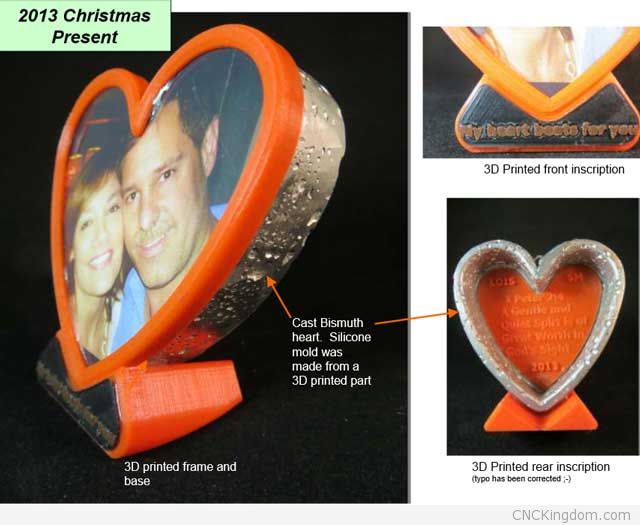
You were an engineer in Naval Ordinance, that has to be one of the coolest jobs on the planet! You get to blow things up and get paid to do it! I was wondering how you got the job and how the overall experience was.
Working for the government had its benefits. The complexity and power of the gun systems amazed me. I also enjoyed some of the really challenging troubleshooting challenges that always came up when we were at sea trying to fix a problem that had stumped several layers of support before it got to us. Naval Ordnance also had one of the most diverse machine shops I’ve ever seen with some machines the size of some houses.
I was fortunate to be able to spend many hours watching all of the machining processes and talking to the machinists to learn how to design parts that could be manufactured. I learned a lot there but ultimately government work was less challenging and I was happy to move on to something faster paced and more challenging.
I’m a huge fan of NASA – I even built a CNC laser Mars Rover Opportunity/Spirit (see http://cncking.com/mars-rover-opportunity.html). Can you share with me some of the projects and products you’ve done for the agency?
I started working for Techshot (www.techshot.com), a NASA contractor in 1999. My first project for Techshot / NASA was a $7M egg incubator. The facility that flew on the Space Shuttle to study embryo development in micro-gravity. Basically it was an incubator that controlled temperature, humidity, as well as oxygen and CO2 partial pressures. It included two centrifuges with each one housing 16 Japanese quail eggs.
One centrifuge spun to provide a 1-g control group and the other was stationary in micro-gravity. The idea was to see how micro-gravity affects embryo development so the system chilled the eggs until they reached orbit then slowly heated them to incubation temperature. The eggs were turned every few hours just like the mother hen does to increase viability. Every two days a couple were “fixed” with para-formaldehyde to provide a snapshot of their development in time. When they came back the scientists could see the development at each stage including some that were hatched after landing. Ultimately they found that were some abnormalities in the micro-g group which has implications for long term space missions.
I’ve also designed a robotic system for NASA research at Brookhaven National Labs. The system allows researchers to maintain 8 sets of samples in a controlled environment and places each one in a radiation beam via a remotely operated computer interface.
I’m currently working on a multi-use platform for the International Space Station that will be used to perform 0-2g testing of seeds, plants, fruit flies, cells in a temperature and gas controlled environment. It has the advantage of being able to house more science specimens than the current system in about 25% of the volume. It also includes a self balancing feature so that any fluids transferred during an experiment won’t induce unwanted vibrations.
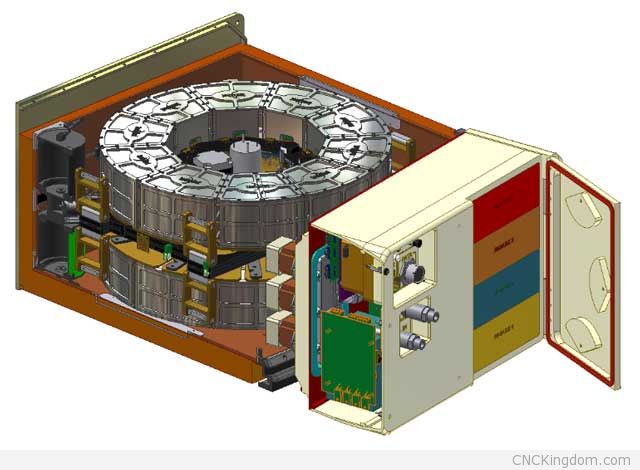
I have to say that working on innovative projects for commercial companies and local entrepreneurs have been my favorites. Projects that take 3-9 months from idea to delivery are the best.
I developed some automated feeding systems and automated litter boxes for IAMS foods that were very innovative and high tech. I designed a generator system that ran off of hydrogen produced from a reaction of water and an aluminum alloy for a local entrepreneur. I used a PLC to regulate the hydrogen reaction and modified a 1000W Honda generator to run off of the hydrogen gas. I designed a large automated heated conveyor system for a company that produces refrigerator parts for GE. I’ve also designed robots used for testing vestibular function.
I think I’ve completed in the neighborhood of 25 projects since I started at Techshot 15 years ago. Probably 1/3rd were for non-government companies or individuals. I enjoyed those projects even more than working on the NASA projects. I’m currently designing a stretcher system for the Army that includes a suspension to prevent further injury of patients due to turbulence during transport flights from one hospital to another.
I love the variety and challenge.
You acquired a patent for remote manipulation of samples. Can you describe how this is different than current methods of sample manipulation and how long the entire process took from initial idea to realized product? How well did the prototype perform? Any licensees yet?
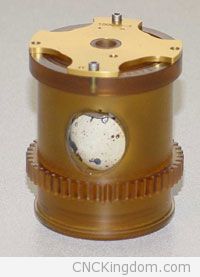
An egg holder of the Avian Development Facility holds a Japanese quail egg for a safe journey to and from space. The holders are designed to isolate the eggs from vibration, thus minimizing any launch and re-entry effects to developing embryos. (NASA/Ames). Visit http://www.nasa.gov/centers/marshall/news/background/facts/adf.html
This patent was for the egg incubator that I described above. It was a team effort and my contribution was only part of the overall patent. The idea started as a high school science experiment devised by the co-founder of Techshot, John Vellinger. It was picked up by KFC who sponsored a rough prototype that flew on the Challenger in 1986. They built another after the Challenger tragedy and the results intrigued scientists so NASA funded the sophisticated system that I helped design.
It took about 2 years from the time we started the flight design until it flew on the Space Shuttle. There are a huge number of safety requirements and an enormous volume of documentation required for systems flying on manned flights so that was a large part of the work.
The system performed flawlessly and the science results raised new questions for long term manned space flight so we were all pleased with the results. It wasn’t designed for commercial application so there haven’t been any licensees.
I’m curious, unless I am wrong, isn’t acquiring a patent going against the idea of “freely sharing” behind the open source community? I know when MakerBot, whose foundations grew from the open source RepRap project, started applying for patents and later bought-out by Stratasys, many in the community were yelling bloody murder. I know I’ve been shot quite a few nasty e-mails through the years by people who really have a problem with what I’m doing at CNCKing.com… having the gull to charge people for CNC projects and not giving my books away for free. I’d really love to read your thoughts on the matter.
I don’t really have any interest in the patent. Its owned by Techshot.
I’m a fan of capitalism, a market economy and of the open source movement. I believe they all complement one another. I would never criticize someone for wanting to charge money for a product that people find useful enough to pay for. When I bought my first 3D printer about this time last year I didn’t know much about the open source movement. About that same time I recruited several guys from a local maker-space to work at Techshot. These guys were huge advocates of the open source movement. I just thought they were naive at first but the more I saw how many good things were coming from the movement the more I started listening to their opinions the more merits I saw in the concept.
A year into it now I believe there’s a place for open source as well as for capitalistic ventures. I see them as synergistic. Just look at 3D printing. Even though Makerbot isn’t open source anymore, look at what they started. There are more open source printers available than any other type and its spawned so many creative iterations all built on the work of some selfless individuals who made huge contributions.
I’m an aspiring entrepreneur and I’m working on several inventions of my own, some of which I hope to eventually market and sell for profit. At the same time I’m making modifications to my 3D printers and as each mod is perfected I’ll be offering them for free on forums, and on websites like Thingiverse and Instructables. I believe that if everyone gave a little bit of their time and talents for free then we would all be better off. I believe this kind of sharing spawns even more opportunity for profit as well.
You told me you bought a 3D Systems 1st Generation CubeX which ended-up being a lemon. Can you describe the issues you were having and how you’d rate the overall company response you received regarding solving the issues you had? What do you use now for cheap 3D printing?
I did a lot of research into 3D printers before I decided that the CubeX would be the right one for me. Based on their advertising it looked like the CubeX Duo was the best choice for someone who didn’t want the printer to be the project rather than the prints.
The printer came 3 months after the promised delivery date but all that frustration was forgotten when I opened the box and assembled this wonderful contraption that I knew would make bring bliss to my life as an inventor.
The CubeX was relatively easy to set up and it was extruding plastic without too much hassle in about an hour. I was elated. The bliss was quickly replaced by great frustration as print after print failed and eventually the extruder clogged.
Technical support consisted one ONE guy in Great Britain supporting thousands of customers. Needless to say, responses were very short and it took him days to get back to me when he even responded. Long story short, I think the printer was inoperable for about 6 of the first 8 weeks I owned it.
During the two weeks that it actually worked over half of the prints failed. I have to say, the few prints that worked like I expected were enough to stoke my fire and keep me going. Eventually Cubify sent a replacement printer after the control card died. The replacement printer self destructed during the first print. Both extruder hot ends were ripped off as the firmware had some kind of glitch that caused the z axis to malfunction.
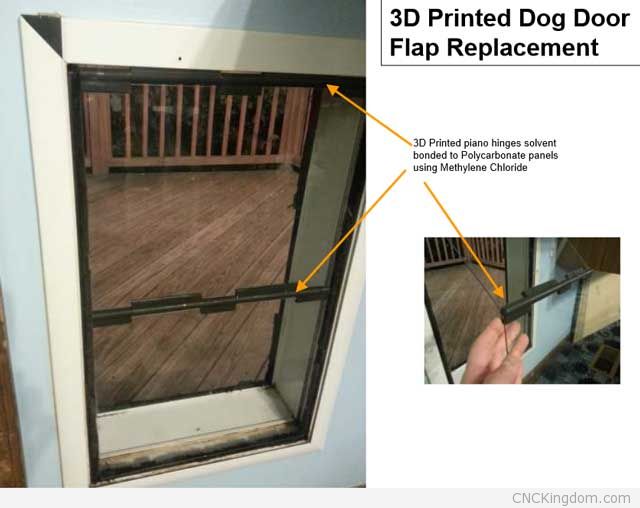
3D printed dog door flap replacement (saved myself the $90 per flap replacement cost). Not made with CubeX.
The filament cartridges constantly jammed and the system that reads the cartridges often wouldn’t work rendering brand new $100 cartridges useless. Cubify sent two more printers (one more than they meant to send) but by that point I was so disgusted with the printer and the lack of support I told them I wanted to send them all back and call it even.
Since they still hadn’t sent all of the filament I originally ordered they had not charged me for the printer yet so I was one of the lucky ones that didn’t get stuck with one of their printers. Once payment is made, they don’t give refunds. I also found out that the prints that Cubify shows sitting next to the CubeX in their marketing materials aren’t even printed by a CubeX printer but by their high end industrial printers.
That entire experience really soured me on Cubify and 3D Systems. I still feel sorry for the one tech support engineer who had to provide tech support for thousands of printers that didn’t work. I’m sure he hates life by now.
The main problem I have with Cubify printers, above all that I’ve mentioned already, is the cost of their proprietary filament. There’s not much information available about the cost of their filament but based on measurements I took while I had the CubeX they charge $100 for 0.6kg of filament. Let’s round that down to $160/kg. I can buy the same quality of filament for pretty much any other brand of printer for $40/kg.
Cubify claims that they control quality and the cartridges keep the filament desiccated (dry). That’s a smokescreen for their business model for making a killing on filament by charging a 400% markup above fair commercial value. The cartridges are NOT air tight and they contain a tiny little desiccant pack which probably wouldn’t last a day in a humid environment. Just to give you an idea of how much money using a Cubify printer will cost you let’s do a little math…
Let’s say you print 1kg of plastic per month (including all the print fails you will get with their machine). That’s a very conservative estimate since many of us print 2x to 5x that much or more. Over the course of one year that means a Cubify printer will cost you 12 x ($160-$40) = $1440 more for the same number of prints. If you assume a printer will last for 5 years before you have to replace it then that’s a total of $7200 more just for filament. Buyer beware. For that reason alone, in my opinion, its a disservice to the 3D printing community for any blogger to sing the praises of any of the Cubify products.
After sending the CubeX back, I ordered a Lulzbot TAZ. I saw a video of a Lulzbot in action on a friend’s Facebook page and I was amazed how fast it printed compared to the CubeX. I actually thought the video I saw was in fast motion but the Lulzbot was just that much faster (150 mm/s for the Lulzbot vs 15 mm/s for the CubeX). I hoped that I would finally experience printing Nirvana when the Lulzbot came.
I opened the box and was very disappointed to see that the TAZ hardware wasn’t nearly as high end as the CubeX printer. To be honest, it looked like a toy compared to the CubeX. I was skeptical but I was committed to make 3D printing work so I tried it out. After some initial success I had an enormous amount of trouble getting prints to work at all. I was about to give up and send the TAZ back when my first roll of filament ran out and I found that the next roll printed much better! I had a bad roll of filament and never thought about that being the problem. I really like the large build volume of the TAZ but it still seemed that I was still getting way more print fails than I should.
To be fair, the Lulzbot tech support was VERY responsive but ultimately I didn’t want to spend hours on the phone going through all the steps required to home in on the problem so I kept trying to solve it on my own. That wasn’t their fault but simply impatience on my part. Eventually I still wasn’t satisfied so I bought another printer.
It turns out the third try was a charm. I bought a MakerGear M2 printer and it was pretty much what I envisioned 3D printing to be in the first place. I still have occasional print failures but they are a small percentage of my prints and the precision and control I get with this printer is excellent. I’ve had several prints that rival prints that I get from commercial 3D printers. The M2 put the joy in 3D printing for me. I’m also happy with the quality of the components used in the M2. It has a few parts that I will redesign but overall its a solid machine. There are several other good printers out there now also such as the Makerbot, Afina, Ultimaker, Solidoodle, and a few others.
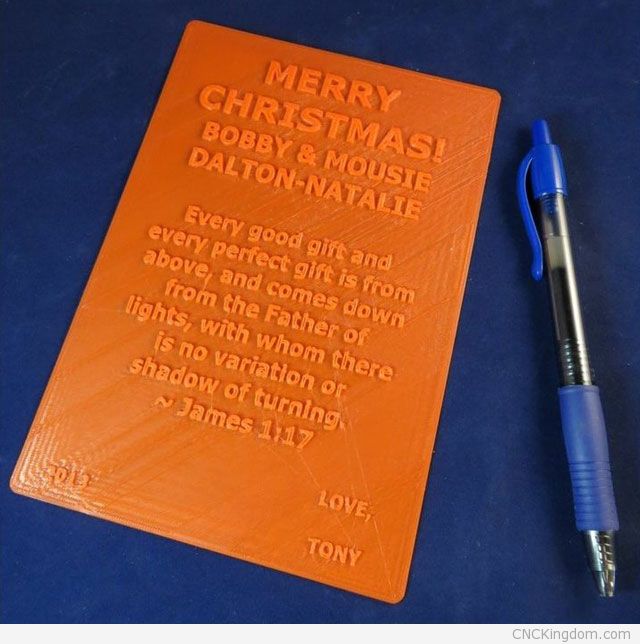
You’ve been doing product and business development at Techshot for over 15 years, what are some of the common issues you see repeatedly in your space and what are the solutions to these problems? What CNC equipment do you have in your shop to help you with product development and do you offer manufacturing expertise as well?
Probably the biggest issue I see is integrating information from design phase all the way through manufacture and delivery. We use one system for CAD, one system for project management, one system for procurement, and another system for accounting, and another system for customer management. I believe that the company that can deliver a system that can integrate all of those functions into one database that prevents multiple entry of information will have a real winner.
Another issue is the exorbitant time (money) it takes to build and review part and assembly drawings for manufacture. I believe a CAD package that would allow adding drawing notes into a 3D model file that could be viewed, measured and converted to CNC code via a free package available to any vendor would save us 10-20% on most projects.
We have a Haas CNC mill and we used to have a full time machinist to build our prototypes. He left so now we rely heavily on local machine builders and rapid prototyping to get ideas and prototypes built quickly to prove concepts before building the final versions.
We rely heavily on companies like Quickparts and Protomold to provide cost effective and quick turnaround parts for our projects. Increasingly I’m relying on my personal M2 printer to build prototypes for testing before we spend thousands on high end SLS prototypes. The M2 is a great machine to build prototypes that don’t require machining tolerances and I can print them for about 1% of the cost and have it ready for testing a fraction of the time compared to ordering a SLS version of the same part from Quickparts.
What is it about designing products that you enjoy so much? You have a woodworking and machine shop… that must be so much fun to go in there and spend hours tinkering and building.
I love creating and building. I always have. I guess its just part of my DNA. I can picture concepts in my mind in 3D very easily and that makes it easy for me to go through many iterations until I land on one that seems likely to work before I even make the first sketch or make the first prototype. It took me a long time to realize that most people can’t do that. I’m not bragging, it just a gift. I’m fashion challenged and when it comes to being diplomatic some might think I’m quite challenged there. But, I can dream up and build things in my mind so that makes me a decent innovator.
I’ve also always had an entrepreneurial bent. I bought my machine shop equipment when I saw that some of the plastic work Techshot was buying cost about 5x as much as I could make it for using a table saw with some milling for 20% of the detailed features. I quoted some jobs and made enough money to pay for all of my machine shop equipment. The project that fed that batch of work finished and now I use the equipment for home projects and inventing. Eventually I’d love to get a CNC router and laser. A CNC mill would be great too but I can’t justify the cost just yet.
My greatest joys are inventing and teaching. The 3D printer has reignited my inventing passion since I can often go from idea to prototype in just a few days including CAD design, printing and prototype iterations.
Some of my projects over the past 9 months or so include a motorized foot massager to alleviate plantar fasciitis, a remote control blind opener, a housing design for a low cost remote controlled 7 segment LED display, a low cost device to remove odors from the toilet during use (100% effective by the way), a large format articulated dog door that won’t warp or discolor, a leveling system for my TAZ printer, a 3D printed right angle gearbox, a custom designed 3D printed novel gear reduction system, a remote radar detector housing that looks like a rear tail-light housing, a yarn holder, a couple custom phone holders, a 3D printed phone amplifier, custom designed 3D printed Christmas cards and ornaments, and several custom designed magnetic toys.
I’m also working on a heated enclosure for my M2 printer to allow warp free printing of large ABS parts of which several of the parts will be 3D printed.

3D printed novelty 2:1 gear reduction
